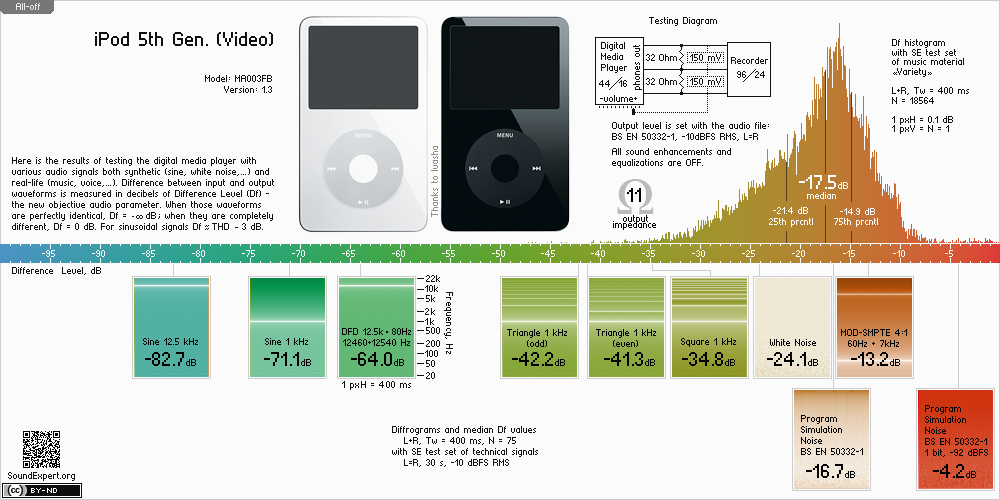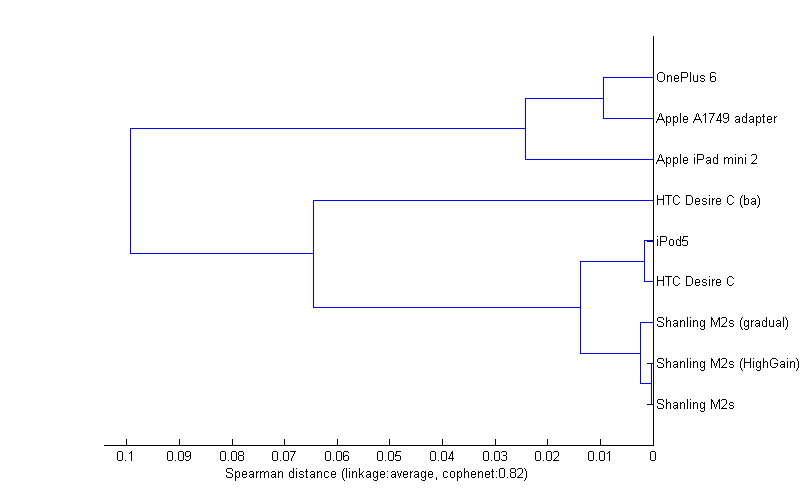Published Date 5/17/19 11:30 AM
 This audio player is from 2005. Like almost all portable players by Apple it was remarkable for its audio quality and usability. Many early iPods are still in use and can be easily found on eBay. Such well-known “anchor” players from the past are important points on the global AQ map, SE is trying to build.
This audio player is from 2005. Like almost all portable players by Apple it was remarkable for its audio quality and usability. Many early iPods are still in use and can be easily found on eBay. Such well-known “anchor” players from the past are important points on the global AQ map, SE is trying to build.
Figure 1. Recording of SE test sequences, which include both technical signals and various music material (the test set "Variety"). Processing of these records results in standard df-measurements presented on Fig.2 below.

Figure 2. Df-slide with audio measurements of the iPod. It can be compared with Df-slides of other devices on the Portable players page.
Artifact signature of iPod 5th differs substantially from modern audio solutions by Apple. Sine 1kHz is distorted 10dB higher than sine 12.5kHz. Relative position of triangle signals on Df scale indicates that odd harmonics prevail in the distortions. Almost all tech. signals with this iPod show worse Df levels than with modern ordinary spartphones. High output impedance. Definitely this device has noticeable sound character.
Conclusion:
Thanks to Wolfson audio chip with relatively high level of waveform degradation iPod 5th (Video) has its own distinctive sound signature (slightly harsh mids, transparent highs). Some music types/genres can benefit from this artifact signature, some other will not. As a result there always be lovers and haters of this player. Starting from iPhone 4 and iPod 6th Gen. Apple uses much more transparent/neutral audio chips from Cirrus Logic. High-Ohm headphones are recommended for this iPod 5th.
Appendix
All-off | 1 | 2 | 3 | 4 | 5 | 6 | 7 | 8 | 9 | 10 | 11 | 12 | 13 | 14 | 15 | 16 | 17 | 18 | 19 | 20 | 21 | 22 | 23 | 24 | 25 | 26 | 27 | 28 | 29 | 30 | 31 | 32 | 33 | 34 | 35 |
__ref1.wav(44)__mono_400-30.4699-20.6489-0.5469.png) | __ref2.wav(44)__mono_400-31.6282-16.7486-5.0098.png) | __ref3.wav(44)__mono_400-23.4016-15.9652-6.8888.png) | __ref4.wav(44)__mono_400-31.0432-23.2037-13.5675.png) | __ref5.wav(44)__mono_400-35.0538-16.7379-8.8951.png) | __ref6.wav(44)__mono_400-31.4328-17.2911-9.8832.png) | __ref7.wav(44)__mono_400-33.3250-22.4616-16.4660.png) | __ref8.wav(44)__mono_400-22.8465-16.3274-7.7172.png) | __ref9.wav(44)__mono_400-33.2010-14.2131-11.2794.png) | __ref10.wav(44)__mono_400-23.7003-14.3339-2.5027.png) | __ref11.wav(44)__mono_400-28.8207-20.0487-1.9347.png) | __ref12.wav(44)__mono_400-26.3523-15.4864-10.8882.png) | __ref13.wav(44)__mono_400-29.9956-18.2208-10.8074.png) | __ref14.wav(44)__mono_400-30.9671-17.8166-9.6137.png) | __ref15.wav(44)__mono_400-33.7086-25.5886-3.6515.png) | __ref16.wav(44)__mono_400-30.4376-18.0337-3.4539.png) | __ref17.wav(44)__mono_400-32.7232-24.5486-0.7925.png) | __ref18.wav(44)__mono_400-25.3233-16.3504-12.3744.png) | __ref19.wav(44)__mono_400-33.6784-23.3079-8.2515.png) | __ref20.wav(44)__mono_400-47.1449-28.7881-11.4933.png) | __ref21.wav(44)__mono_400-29.3120-23.0726-1.4742.png) | __ref22.wav(44)__mono_400-26.4795-14.6798-10.0052.png) | __ref23.wav(44)__mono_400-25.0668-17.3207-14.2030.png) | __ref24.wav(44)__mono_400-22.5757-11.7639-9.6049.png) | __ref25.wav(44)__mono_400-27.4252-18.4647-10.1176.png) | __ref26.wav(44)__mono_400-35.0708-16.8534-10.6444.png) | __ref27.wav(44)__mono_400-39.1463-15.0031-2.1247.png) | __ref28.wav(44)__mono_400-39.8078-11.1503-9.3620.png) | __ref29.wav(44)__mono_400-23.7256-16.7645-10.6445.png) | __ref30.wav(44)__mono_400-30.0093-17.5956-3.0336.png) | __ref31.wav(44)__mono_400-27.6871-16.6779-8.3974.png) | __ref32.wav(44)__mono_400-30.7702-12.0178-6.5302.png) | __ref33.wav(44)__mono_400-32.3281-24.2130-5.6944.png) | __ref34.wav(44)__mono_400-43.8475-17.2155-10.8228.png) | __ref35.wav(44)__mono_400-34.9451-19.6155-15.8121.png) |
| -20.6 | -16.7 | -16.0 | -23.2 | -16.7 | -17.3 | -22.5 | -16.3 | -14.2 | -14.3 | -20.0 | -15.5 | -18.2 | -17.8 | -25.6 | -18.0 | -24.5 | -16.4 | -23.3 | -28.8 | -23.1 | -14.7 | -17.3 | -11.8 | -18.5 | -16.9 | -15.0 | -11.2 | -16.8 | -17.6 | -16.7 | -12.0 | -24.2 | -17.2 | -19.6 |
Figure 3. Diffrograms of 35 tracks of the test set “Variety”, played back through iPod 5th (Video). They show level of waveform degradation of the musical signal divided into 400ms chunks (one pixel each, max. degradation is Red). Median Df values of the tracks are indicated. Click a track to open in full size for quick comparison with similar tracks from another device. More about diffrograms → Diffrogram: visualization of signal differences in audio research.
| Figure 4. Dendrogram showing similarity of artifact signatures of tested players. The shorter the link between two players, the more similar their artifact signatures. |  |
It looks like average linkage for the dendrogram better reveals clusterization of players according to their artifact signatures. So it will be used instead of complete linkage from now on.
Table 1. Underlying matrix of Spearman distances between artifact signatures for the dendrogramm. The Spearman distance = 0.1 is critical for relation of Df measurements to subjective scores. For the players that have similar artifact signatures (distance < 0.1) their perceived sound quality correlates well to df-measurements performed with substantial amount of real-life music material (histogram medians). | | (1) (2) (3) (4) (5) (6) (7) (8) (9) |
(1) Apple iPad mini 2
(2) HTC Desire C
(3) HTC Desire C (ba)
(4) Shanling M2s
(5) Shanling M2s (HighGain)
(6) Shanling M2s (gradual)
(7) Apple A1749 adapter
(8) OnePlus 6
(9) Apple iPod 5th (Video) | 0 0.0619 0.0972 0.0445 0.0446 0.0334 0.0374 0.0111 0.0578
0.0619 0 0.0655 0.0149 0.0147 0.0174 0.1494 0.1029 0.0017
0.0972 0.0655 0 0.0651 0.0651 0.0660 0.1710 0.1306 0.0612
0.0445 0.0149 0.0651 0 0.0002 0.0024 0.1378 0.0887 0.0112
0.0446 0.0147 0.0651 0.0002 0 0.0025 0.1379 0.0888 0.0110
0.0334 0.0174 0.0660 0.0024 0.0025 0 0.1229 0.0752 0.0140
0.0374 0.1494 0.1710 0.1378 0.1379 0.1229 0 0.0095 0.1455
0.0111 0.1029 0.1306 0.0887 0.0888 0.0752 0.0095 0 0.0988
0.0578 0.0017 0.0612 0.0112 0.0110 0.0140 0.1455 0.0988 0 |